| Nr | Nosaukums | Apraksts |
|---|---|---|
|
Avinurmes dzīves veida centrā ir izstādīta izzinoša ekspozīcija par apkārtnes kultūras vēsturi, atvērtas kokapstrādes un rokdarbu darbnīcas. Kokapstrādes darbnīcā iespēja strādāt uz vecmodīga ēvelsola. Rokdarbu darbnīcā varēsiet izmēģināt dzijas šķeterēšanu un auduma aušanu. Grupām ir sagatavotas īpašas 1 - 3 stundu ilgas programmas. |
||
|
Viesu māja "Hilda Villa" atrodas Igaunijā, Vīlandes pilsētiņas centrā. Viesu mājā ir īpašas istabiņas ģimenēm līdz 4 personām. Viesu mājas 1. stāvā atrodas Hildas istaba, Tenantas istaba, kā arī vannas istaba, dzīvojamā istaba un virtuve. 2. stāvā ir 3 guļamistabas, 2 dušas un 2 tualetes. |
||
|
Pēterbaznīca ir ne tikai viens no Baltijas vecākajiem vēstures pieminekļiem, bet arī labākā vieta UNESCO Pasaules kultūras mantojuma – Rīgas vēsturiskā centra apskatei. Redzama Vecrīgas centrālā daļa, Rātslaukums, Pārdaugava un skaidrā laikā Rīgas jūras līcis. Dievnama torņa augstums ir 123 m, bet skatu vieta atrodas 72 m augstumā.
|
||
|
Viens no raksturīgiem karsta parādību piemēriem, kur nelielas upītes - strauta ūdeņi pazūd vairākos ūdensrijējos un pēc kāda brīža - iespaidīgās Lauces ielejas krastos iznāk spēcīgu avotu veidā, tālāk ieplūzdami Lauces upē. Šī parādība dinamikā vislabāk ir novērojama pēc lietavām vai pavasaros sniega kušanas laikā un kādu brīdi pēc tam. |
||
|
Kafejnīca "Policijas akadēmija" ir iecienīta maltīšu ieturēšanas vieta Ogres centrā. Atrodas pirms Pirmā pasaules kara celtā ēkā, kur padomju laikā atradās milicijas iecirknis. Piedāvā mūzikas vakarus. Latviešu virtuve: „Sierštelles” sieru kārtojums, jēra gaļas zupa, sēņu zupa, grūbas ar sēnēm, sama fileja, meža ogu sorberts, pankūkas. Īpašais ēdiens: Cepta siera kūka ar ogām. |
||
|
Kvalitatīvs restorāns un viesnīca Ainažos. Restorāna ēdienkarte ir ļoti dažāda - no vieglām un interesantām uzkodām, līdz lieliskiem gaļas un zivju ēdieniem, kā arī veģetārajiem piedāvājumiem! Ikdienā restorānu apmeklē ne tikai Latvijas, bet arī daudz kaimiņu zemju klientu! Restorāns ir draudzīgs gan ģimenēm, gan arī mājdzīvniekiem. |
||
|
Atpūtas kompleksā ir iespējams gan makšķerēt karpu dīķī, gan peldēties un sauļoties labiekārtotā pludmalē uz zviļņiem. Bērniem ir izveidots rotaļu laukums. Iespējams rīkot arī banketus, seminārus un citus pasākumus. Tāpat pieejama pirts ar kamīnzāli atpūtai līdz 20 cilvēkiem. Nakšņošanai tiek piedāvāti četri kempingi, kas izvietoti virs ūdens uz pāļiem. Visi namiņi ir apsildāmi, ar atsevišķu dušu un tualeti, TV un wi-fi internetu. Divos no tiem ir pieejama virtuve, bet vienā - arī kamīns. Katrā namiņā ir trīs vai četras gultasvietas. Tāpat pieejamas telts un kemperu vietas, iespējams uz vietas arī iznomāt teltis.
|
||
|
"Vinetas un Allas kārumlāde" ir kafetērija - konditorejas veikals Cēsīs, kur iespējams nobaudīt uz vietas vai iegādāties līdziņemšanai dažādus saldos un sāļos nakšķus. Kafetērijā iespējams baudīt tēju, kafiju un citus dzērienus, kā arī arī vieglas pusdienas. Tiek pieņemti pasūtījumi. Konditori uz vietas gatavo plātsmaizes, pīrādziņus, cepumus, konfektes un daudzi citus gardumus. Ļoti populāras ir saldās un sāļās tortes, dažādu našķu asorti jubilejām un tortes pasaku tēlu veidā bērnu dzimšanas dienām. Kāzām - skaistās marcipāna tortes vairākos stāvos. Šeit gatavo arī visdažādākās slavenās marcipāna un šokolādes figūriņas, no kurām melnie un baltie gulbji, kā arī Cēsu viduslaiku pils ir kļuvušas par ļoti iecienītu suvenīru. Ļoti iecienīti ir arī rudzu produkti - rupjmaizes kūka, tradicionālais rupjmaizes kārtojums, Kurzemnieku rauši, rudzu maizes tosts ar siļķi, cepumi. |
||
|
This tour can be done with your own or rented car and it includes driving, some hiking parts and transfers with the public transport. This grand Forest Trail and Baltic Coastal Hiking Route tour includes some of the best and most beautiful parts of the Forest Trail and Baltic Coastal Hiking Route in Lithuania and the southern part of Latvia. Hikes are combined with trips and excursions in cities, as well as other popular tourist sights in both countries. You will get a detailed impression about the forest diversity, coastal landscape and most popular national and regional nature parks in Latvia and Lithuania.
At the end of the tour you will go for a 1 day hike in Kurtuvėnai Regional Park which is one of the most forested areas in Central Lithuania with very pronounced glacier-shaped terrain forms spread in the Eastern Žemaitija Upland. |
||
|
Atrodas Rucavas galvenās ielas malā, netālu no centra.Rucavas draudzi dibināja 1871. gadā, bet izmēros nelielo dievnamu uzcēla 1888. gadā. |
||
|
Viena no retajām vietām, kur apskatāma un iepazīstama Sēlijas vēsturiskajam novadam raksturīga „dzīva” sēta ar tās plānojumu un tipiskām ēkām. Saimnieki kolekcionē senos sadzīves un saimniecības priekšmetus. Piedāvā ekskursiju, ārstniecības augu kolekciju, melno pirti un sēļu ēdienus. Izejvielas ražo paši un sadarbojas ar zemniekiem. Latviešu virtuve: Plānās pankūkas, grūbu zupa, kartupeļu biezzupa, sautētas pupas īpašā mērcē, buberts, maizes zupa ar putukrējumu, tortes, zāļu tējas. Īpašais ēdiens: Cepelīni. |
||
|
Ģimenes veidots un vadīts uzņēmums Ziemeļkurzemes piekrastē, kas piedāvā ieskatu zvejniecības un latviskā dzīvesstila tradīcijās. Tiek popularizēti vietējie produkti, kas nākuši no jūras un apkārtnes mežiem, sagatavojot un pasniedzot tos gan senās tradicionālās, gan mūsdienu latviešu virtuves interpretācijās. Piedāvājumā gan pastāvīga ēdienkarte, gan sezonāls piedāvājums. Pasākumu organizēšana grupām ''Mielasts zvejnieku sētā'' (piekrastes tradīcijas, zivju mielasts, izbrauciens ar zvejas laivām), kā arī baudāmas un izzinošas meistarklases ''Ražots Rojā'' (Rojas novada zivju pārstrādes uzņēmumu produkcijas un restorāna virtuves zivju ēdienu degustācijas un iespēja pašiem pagatavot), ''Nacionālās virtuves īpatnības'' (sezonālie latviešu ēdieni - zivis ( kūpināšana, nēģu sagatavošana u.c.), Jāņu siers, bukstiņputra, sklandu rauši u.c. pēc viesu vēlmēm un pieprasījuma), ''Reņģēdāju dzīres'' (zivs, tās sagatavošana, ēdienu pagatavošana un degustēšana),''Dižraušu dzīres'' (sklanda rausis - oriģinālās un inovatīvās versijas, to gatavošana, degustēšana). Piedāvājumā vietējo uzņēmumu produkciju - plašs zivju konservu klāsts, Sabiles vīns un sidrs, augļu un ogu sukādes, pašu saimniecībā spiesta EKO ābolu sula u.c. |
||
|
Unikāla dabas teritorija – Dvietes senleja ar Skuķu un Dvietes ezeriem un senlejai pieguļošajām palieņu pļavām, kas plūdu laikā darbojas kā sava veida Daugavas ūdeņu „uzkrājējs” jeb ventilis. Tā ātri uzņem lielas palu ūdeņu masas, bet vēlāk tās lēnām atdod. Senlejas ūdens līmeņa svārstību īpatnības ir iemesls savdabīgajai senlejas ekosistēmai, kas ir nozīmīga augu un putnu dzīves vieta gan migrāciju, gan ligzdošanas laikā. Skatīt arī Dvietes palu zinas |
||
|
Viesu nams "Stikāni" atrodas 2km no Nagļiem, pašā Orenīšu dīķu krastā. Viesu namā atrodas 4 labiekārtoti, komfortabli divvietīgi numuriņi un ēdamistaba ar izeju uz dārza terasi. Viesi var pasūtīt ēdināšanas pakalpojumus vai arī gatavot paši - virtuvē ir viss nepieciešamais aprīkojums. Blakus ēkā atrodas dabas tūrisma informācijas centrs, kurā ceļotāji var pieteikties putnu vērošanas ekskursijām tuvējā apkaimē. Mājai piederošajā teritorijā ir izveidota dabas taka, kurā zinoša gida pavadībā iespējams iepazīt Latvijai raksturīgos kokus un krūmus, populārus un mazāk zināmus ārstniecības augus un lielu daļu pie mums ligzdojošo putnu (vasarā) vai arī vērot iespaidīgu putnu migrāciju pavasaros un rudeņos. Dārzā putnus var vērot arī no speciāla slēpņa. |
||
|
Krodziņš "Dzirnakmeņi" atrodas Ieriķu centrā pie Ieriķupītes, kur izveidota dabas taka ūdenskritumu un dzirnavu apskatei. Pašcepti konditorijas izstrādājumi. Latviešu virtuve: Valmieras salāti, aukstā zupa, pupiņu zupa, cūkgaļas šķēle, cepta menca, kupāti, rupjmaizes kārtojums. Īpašais ēdiens: „Ieriķu salāti” – tomāti, žāvēta gaļa, šampinjoni. |
||
|
Stādaudzētava piedāvā rožu, skujeņu, dižstādu, ūdensaugu, lapu krūmu un dzīvžogu materiāla iegādi un konsultācijas.
|
||
|
Smēdē taisa žogus, vārtus, vēja rādītājus, lustras, sadzīvē izmantojamus priekšmetus un suvenīrus. Interesentiem stāsta par kalēja darbu un demonstrē prasmes. |
||
|
Lokveida taku var iziet tikai Slīteres nacionālā parka gida pavadībā, jo tā izveidota dabas rezervāta zonā. Pa stāvajām kāpnēm, kas izveidotas Baltijas ledus ezera senkrastā, nokāpsim citā pasaulē, kur var iepazīt nogāžu un platlapju mežus, avoksnāju, kaļķainu zāļu purvu (visi – aizsargājami biotopi), kā arī senas meliorācijas grāvju atliekas un trupējošus egļu stumbrus (svarīgi sugu daudzveidībai), kas saglabājušies no 1969. gada orkāna laikiem. Taka sākas pie Šlīteres bākas. |
||
|
Podnieki nodarbojas gan ar dažādu laikmetu tradicionālo podniecību, gan mēģina izzināt senās formas, materiālus un metodes, ar kurām darbojušies senči iepriekšējos gadsimtos. Ekskursija, cepļa apskate, darbošanās ar mālu, keramikas darbu iegāde, seno darbarīku un keramikas kolekcijas apskate. Aicina uz cepļa atvēršanu. |
||
|
Atrodas austrumos no Alūksnes Tempļa kalna un dienvidos no Lieliem kapiem – Tempļa kalna parkā. Skatu torņa platforma atrodas apmēram 30 m augstumā virs Alūksnes ezera ūdeņiem. Labi redzama Marijas sala, Alūksnes parks, Alūksnes ezera piekraste līdz Kolberģim un Lāzberģim. Izcili ainavisks skats! |
||





















